Investigating Seasonal Water Quality Dynamics in Humid, Subtropical Louisiana Facultative Waste Stabilization Ponds
Abstract
1. Introduction
2. Materials and Methods
2.1. Study Area
2.2. Waste Stabilization Pond Description
2.3. Water Quality Sensor Data Collection
2.4. Statistical Analysis
3. Results
3.1. Yearly Water Quality Parameters
3.2. Settling Pond Statistical Analysis
3.2.1. Complete Study Period
3.2.2. Seasonal Intervals
3.2.3. Monthly Canonical Correlation Analysis
3.3. Secondary Treatment Statistical Analysis
3.3.1. Complete Study Period for S2
3.3.2. Seasonal Intervals
3.3.3. Monthly Canonical Correlation Analysis
4. Discussion
4.1. Trends in Yearly WSP Dataset
4.2. Seasonal Water Quality Response in Settling Pond
4.3. Secondary Treatment Pond Nitrogen Correlations
4.4. Monthly Indicators for Improved Optimization
5. Conclusions
Author Contributions
Funding
Data Availability Statement
Acknowledgments
Conflicts of Interest
References
- Butler, E.; Hung, Y.; Ahmad, S.; Yeh, R.; Liu, R.; Fu, Y. Oxidation Pond for municipal wastewater treatment. Appl. Water Sci. 2017, 7, 31–51. [Google Scholar] [CrossRef]
- Passos, R.; Ferreira, V.; von Sperling, M. A dynamic and unified model of hydrodynamics in waste stabilization ponds. Chem. Eng. Res. Des. 2019, 144, 434–443. [Google Scholar] [CrossRef]
- United States Environmental Protection Agency (US EPA). About Small Wastewater Systems. 2025. Available online: https://www.epa.gov/small-and-rural-wastewater-systems/about-small-wastewater-systems (accessed on 10 September 2025).
- Alves, M.; da Silva, F.; Araújo, A.; Pereira, E.L. First-order removal rates for organic matter in full-scale waste stabilization pond systems in Northeastern Brazil. Water Air Soil Pollut. 2020, 231, 528. [Google Scholar] [CrossRef]
- Moussavi, S.; Thompson, M.; Li, S.; Dvorak, B. Assessment of small mechanical wastewater treatment plants: Relative life cycle environmental impacts of construction and operations. J. Environ. Manag. 2021, 292, 112802. [Google Scholar] [CrossRef]
- Zhang, R.; Wang, Z.; Cai, Z.; Pousseau, D.; Hulle, S. Addressing the rural wastewater treatment dilemma: A techno-environmental-economic analysis. Chem. Eng. J. 2025, 504, 158905. [Google Scholar] [CrossRef]
- Mahapatra, S.; Samal, K.; Dash, R. Waste Stabilization Pond (WSP) for wastewater treatment: A review on factors, modelling and cost analysis. J. Environ. Manag. 2022, 308, 114668. [Google Scholar] [CrossRef]
- Omidina-Anarkoli, T.; Shayannejda, M. Improving the quality of stabilization pond effluents using hybrid constructed wetlands. Sci. Total Environ. 2021, 801, 149615. [Google Scholar] [CrossRef] [PubMed]
- Patyal, V.; Jaspal, D.; Tiwari, A.; Khare, K. Constructed Wetlands for removal of Phosphorus from Domestic Wastewater-A Patent Review. Sustain. Water Resour. Manag. 2020, 8, 1–16. [Google Scholar] [CrossRef]
- Kilian, S.; Paweska, K.; Bawiec, A. Evaluation of post-treatment after wastewater stabilization ponds at municipal wastewater treatment plant. Sci. Rep. 2024, 14, 22257. [Google Scholar] [CrossRef] [PubMed]
- Krimech, A.; Sbahi, S.; Ouzzani, N.; Oudra, B.; Cherifi, O.; Mandi, L. Evaluation of the efficiency of wastewater treatment and the diversity of phytoplankton in a large-scale waste stabilization pond in an arid climate. Ecol. Eng. 2025, 212, 107518. [Google Scholar] [CrossRef]
- Goodarzi, D.; Mohammadian, A.; Pearson, J.; Abolfathi, S. Numerical modelling of hydraulic efficiency and pollution transport in waste stabilization ponds. Ecol. Eng. 2022, 182, 106702. [Google Scholar] [CrossRef]
- Abdo, A.; El-Liethy, M.; Doma, H.; Taweel, G.; Ali, G. Chlorine as an integrated approach for environmental health and hygiene: A case study on evaluation of the performance of waste stabilization ponds located at 11 governorates in Egypt. Emerg. Contam. 2022, 8, 243–253. [Google Scholar] [CrossRef]
- Achag, B.; Mouhanni, H.; Bendou, A. Improving the performance of waste stabilization ponds in an arid climate. J. Water Clim. Change 2021, 12, 3634–3674. [Google Scholar] [CrossRef]
- Ghalhari, M.; Schonberger, H.; Lasaki, B.; Asghari, K.; Milan, E.; Rahimi, N.; Yousefi, S.; vakili, B.; Mahivi, A. Performance evaluation and siting index of the stabilization ponds based on environmental parameters: A case study in Iran. J. Environ. Health Sci. Eng. 2021, 19, 1681–1700. [Google Scholar] [CrossRef]
- Sinn, J.; Agrawal, S.; Orschler, L.; Lackner, S. Characterization and evaluation of waste stabilization pond systems in Namibia. H2 Open J. 2022, 5, 365–378. [Google Scholar] [CrossRef]
- Arslan, M.; Wilkinson, S.; Neaeth, M.; El-Din, M.; Kohkhar, Z.; Walker, C.; Lucke, T. Performance of constructed floating wetlands in a cold climate waste stabilization pond. Sci. Total Environ. 2023, 880, 163115. [Google Scholar] [CrossRef]
- Chen, P.; Zhao, W.; Chen, D.; Haung, Z.; Zhang, C.; Zheng, X. Research Progress on Integrated Treatment Technologies of Rural Domestic Sewage: A Review. Water 2022, 14, 243. [Google Scholar] [CrossRef]
- Rey, A.; Mulligan, R.; Silva, A.; Filion, Y.; Champagne, P.; Boegman, L. Three-Dimensional Hydrodynamic Behavior of an Operational Waste-Stabilization Pond. J. Environ. Eng. 2020, 147, 2. [Google Scholar] [CrossRef]
- Brad, S.; Murar, M.; Vlad, G.; Brad, E.; Popanton, M. Lifecycle Design of Disruptive SCADA Systems for Waste-Water Treatment Installations. Sustainability 2021, 13, 4950. [Google Scholar] [CrossRef]
- Dwarakanath, B.; Kalpana, D.; Ranjith, K.; Ahmed, M.; Ghulam, A.; Bheema, T. Smart IoT-based water treatment with a Supervisory Control and Data Acquisition (SCADA) system process. Water Reuse 2023, 13, 411–431. [Google Scholar] [CrossRef]
- Camargo, E.; Spanhol, F.; Slongo, J.; Silva, M.; Pazinato, J.; Lono, A.; Coutinho, F.; Pfrimer, F.; Lindino, C.; Oyamada, M.; et al. Low-Cost Water Quality Sensors for IoT: A Systematic Review. Sensors 2023, 23, 4424. [Google Scholar] [CrossRef]
- Ho, L.; Jerves-Cobo, R.; Morales, O.; Larriva, J.; Arevalo-Durazno, M.; Barthel, M.; Six, J.; Bode, S.; Boeckx, P.; Goethals, P. Spatial and temporal variations of greenhouse gas emissions from a waste stabilization pond: Effects of sludge distribution and accumulation. Water Res. 2021, 193, 116858. [Google Scholar] [CrossRef]
- Benkov, I.; Tsakovski, S.; Venelinov, T. Assessment of the Water Quality of WWTPs’ Effluents through the Use of Wastewater Quality Index. Appl. Sci. 2024, 14, 8467. [Google Scholar] [CrossRef]
- Meynet, P.; Joss, A.; Davenport, R.; Fenner, K. Impact of long-term temperature shifts on activated sludge microbiome dynamics and micropollutant removal. Water Res. 2024, 258, 121790. [Google Scholar] [CrossRef]
- Ho, L.; Pham, D.; Echelpoel, W.; Muchene, L.; Shkedy, Z.; Alvaradi, A.; Espinoza-Palacious, J.; Arevalo-Durazno, M.; Thas, O.; Goethals, P. A Closer Look on Spatiotemporal Variations of Dissolved Oxygen in Waste Stabilization Ponds Using Mixed Models. Water 2018, 10, 201. [Google Scholar] [CrossRef]
- Yellow Springs Incorporation (YSI) EXO University Practical Tips for Reliable Data EXO University–Calibration. Available online: https://www.ysi.com/exo-university/category/exo-sensor-calibration (accessed on 11 September 2025).
- JMP Statistical Discovery–Student Edition. Available online: https://www.jmp.com/en/academic/jmp-student-edition (accessed on 11 September 2025).
- Duan, R.; Gu, X.; Chang, L.; Cui, X.; Li, X.; You, X.; Zhang, Q. Spatiotemporal variations of nitrogen-nitrate in groundwater and health risk in the parts of Mu Us sandy land, NW China. J. Water Clim. Change 2025, 16, 322–343. [Google Scholar] [CrossRef]
- Roy, B.; Roy, H.; Tahman, K.; Mahmud, F.; Bhuiyan, M.; Hasan, M.; Bhuiyam, A.; Hasan, M.; Mahbub, M.; Jahedi, R.; et al. Principal component analysis incorporated water quality index modeling for Dhaka-based rivers. City Environ. Interact. 2024, 23, 100150. [Google Scholar] [CrossRef]
- Liu, L.; Hall, G.; Champagne, P. Disinfection processes and mechanisms in wastewater stabilization ponds: A review. Environ. Rev. 2018, 26, 417–429. [Google Scholar] [CrossRef]
- Shaheen, M.; Elmahdy, E.; Rizk, N.; Abdo, S.; Hussein, N.; Elshershby, A.; Shahein, Y.; Fawy, M.; El-Liethy, M.; Marouf, M.; et al. Evaluation of physical, chemical, and microbiological characteristics of waste stabilization ponds, Giza, Egypt. Environ. Sci. Eur. 2024, 36, 1–19. [Google Scholar] [CrossRef]
- Samal, K.; Samal, S.; Senapati, S.; Panda, A.; Reddy, N. A Review of the Impact of Climatic Factors on the Performance of Oxidation Pond (OP) and Its Linkage to the Circular Economy. Air Soil Water Res. 2025, 18, 11786221251336835. [Google Scholar] [CrossRef]
- Siddik, M. Application of machine learning approaches in predicting estuarine dissolved oxygen (DO) under a limited data environment. Water Qual. Res. J. 2022, 57, 140–151. [Google Scholar] [CrossRef]
- Santos, S.; van Haandel, A. Transformation of Waste Stabilization Ponds: Reengineering of an Obsolete Sewage Treatment System. Water 2021, 13, 1193. [Google Scholar] [CrossRef]
- Achag, b.; Mouhanni, H.; Bendou, A. Hydro-biological characterization and efficiency of natural waste stabilization ponds in a desert climate (city of Assa, Southern Morocco). Aqua Water Infrastruct. Ecosyst. Soc. 2021, 70, 361–374. [Google Scholar] [CrossRef]
- Alsulaiulu, A.; Rafaie, A. Artificial neural network modeling approach for the prediction of five-day biological oxygen demand and wastewater treatment plant performance. Water Supply 2021, 21, 1861–1877. [Google Scholar] [CrossRef]
- Haung, Y.; Ragush, C.; Johnston, L.; Hall, M.; Beiko, R.; Jamieson, R.; Hansen, L. Changes in Bacterial Communities During Treatment of Municipal Wastewater in Arctic Wastewater Stabilization Ponds. Front. Water 2021, 3, 710853. [Google Scholar] [CrossRef]
- Nair, A.; Hykkerud, A.; Ratnaweera, H. Estimating Phosphorus and COD Concentrations Using a Hybrid Soft Sensor: A Case Study in a Norwegian Municipal Wastewater Treatment Plant. Water 2022, 14, 332. [Google Scholar] [CrossRef]
- Assefa, E.; Jabasingh, A.; Mulugeta, E.; Dessalenge, M.; Teju, E. Impact of source water quality on total organic carbon and trihalomethane removal efficiency in a water treatment plant: A case study of Upper Awash, Ethiopia. J. Water Health 2024, 22, 337–349. [Google Scholar] [CrossRef] [PubMed]
- Park, J.; Craggs, R.; Tanner, C. Eco-friendly and low-cost Enhanced Pond and Wetland (EPW) system for the treatment of secondary wastewater effluent. Ecol. Eng. 2018, 120, 170–179. [Google Scholar] [CrossRef]
- Trach, Y.; Bujakowski, F.; Koda, E.; Mazur, L.; Nejbery, K.; Podlasek, A.; Vaverkova, M. Characterization of adsorbents from Ukrainian kaolinite clay for the sorption of nickel: Insight and practical application for water treatment in conditions of economic constraints. Desalination Water Treat. 2022, 278, 1–12. [Google Scholar] [CrossRef]
- Achag, B.; Mouhanni, H.; Bendou, A. Performance of municipal waste stabilization ponds in the Saharan desert (Morocco). J. Water Clim. Change 2023, 14, 1741–1761. [Google Scholar] [CrossRef]
- Sutherland, D.; Heubeck, S.; Park, J.; Turnball, M.; Craggs, R. Seasonal performance of a full-scale wastewater treatment enhanced pond system. Water Res. 2018, 136, 150–159. [Google Scholar] [CrossRef] [PubMed]
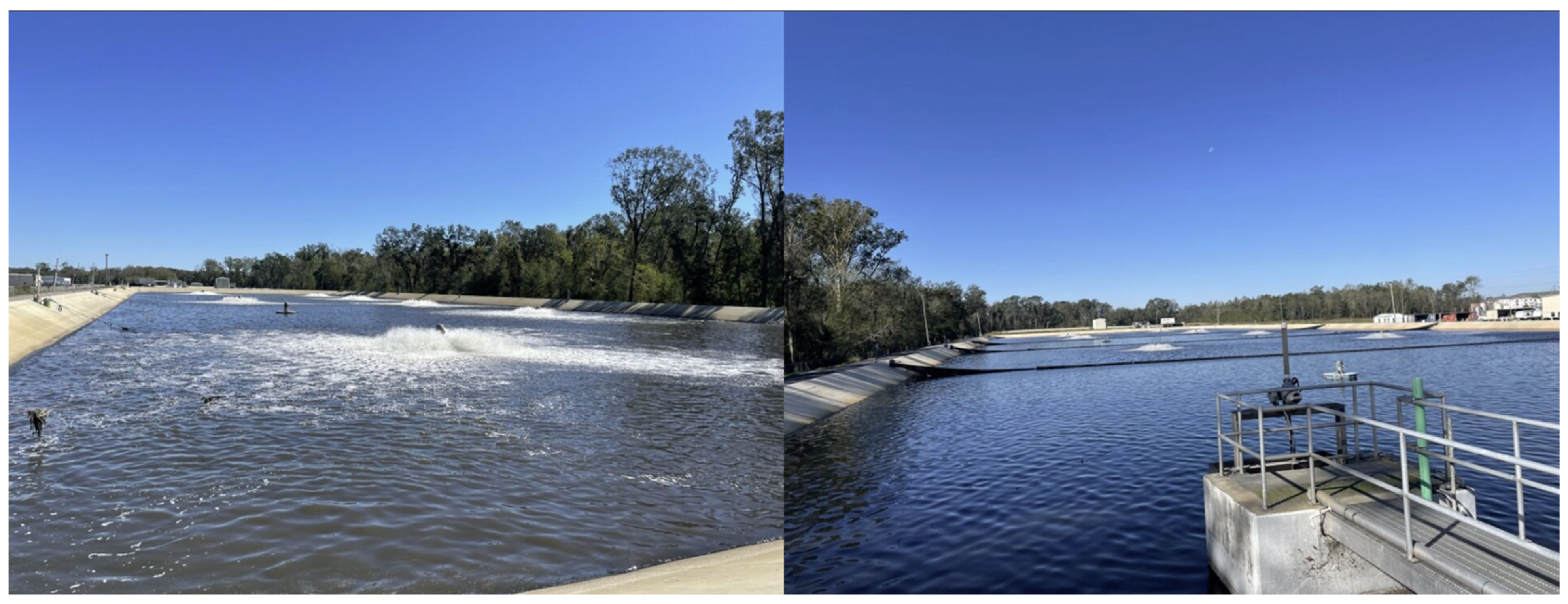

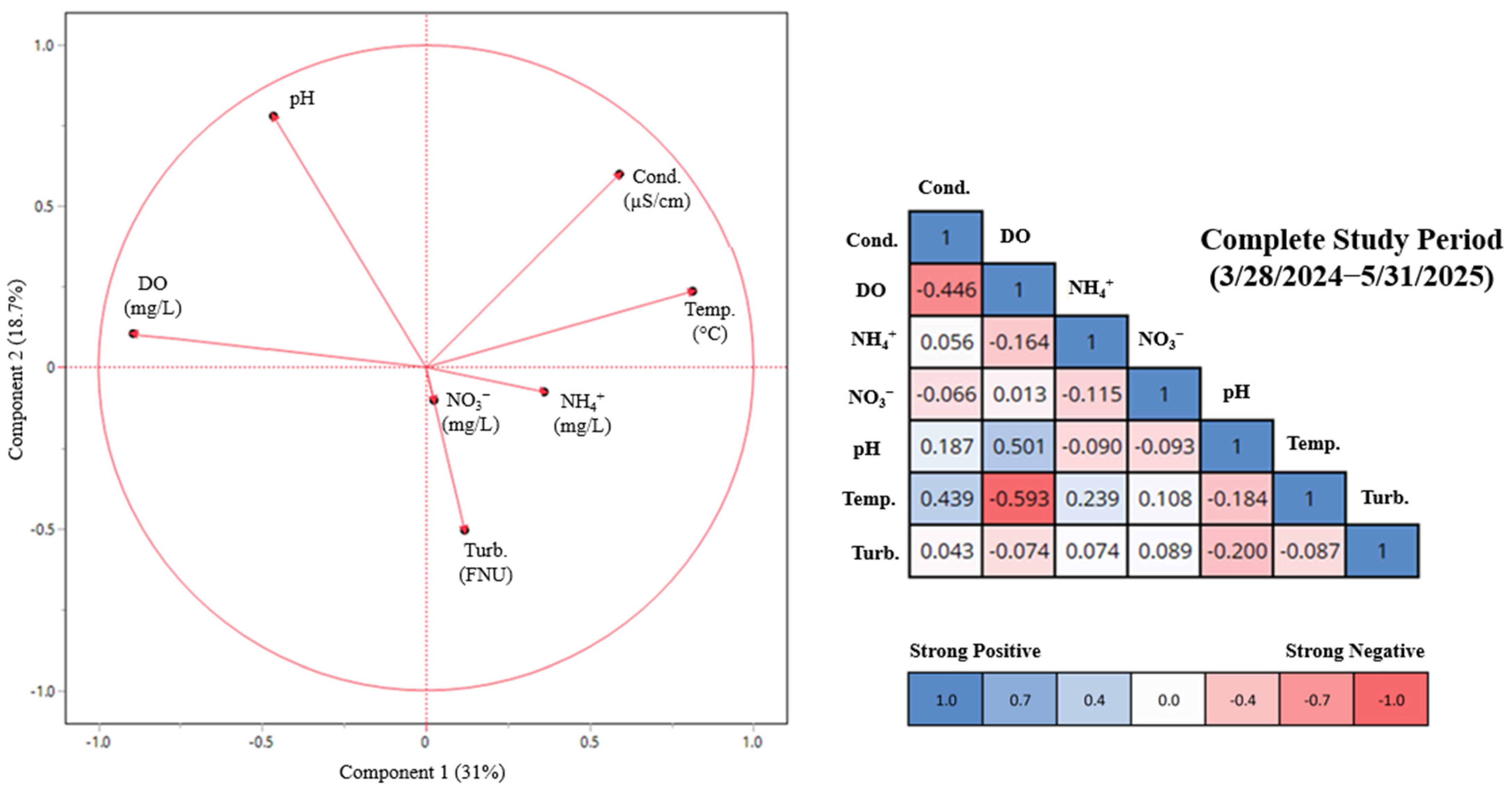
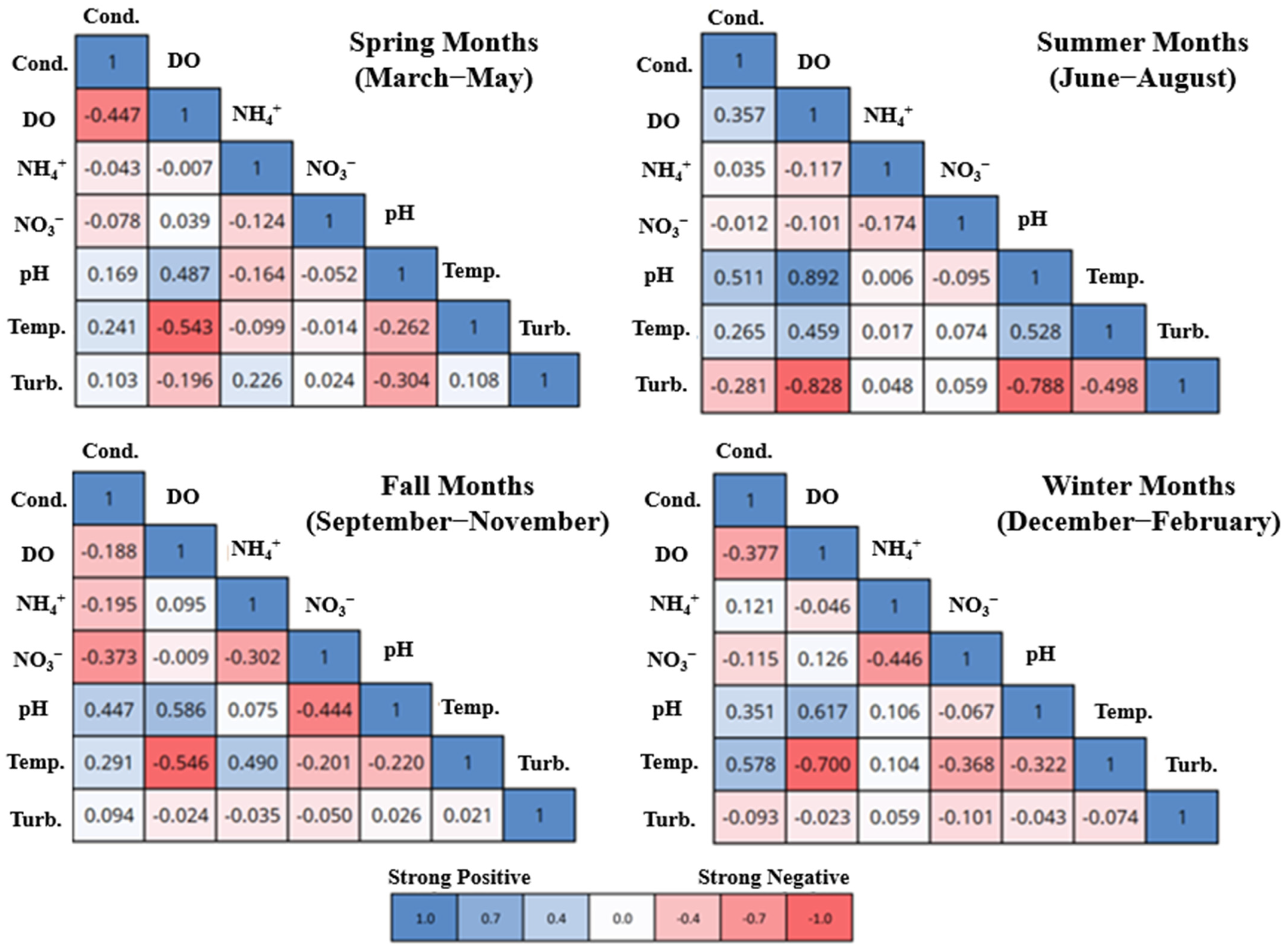

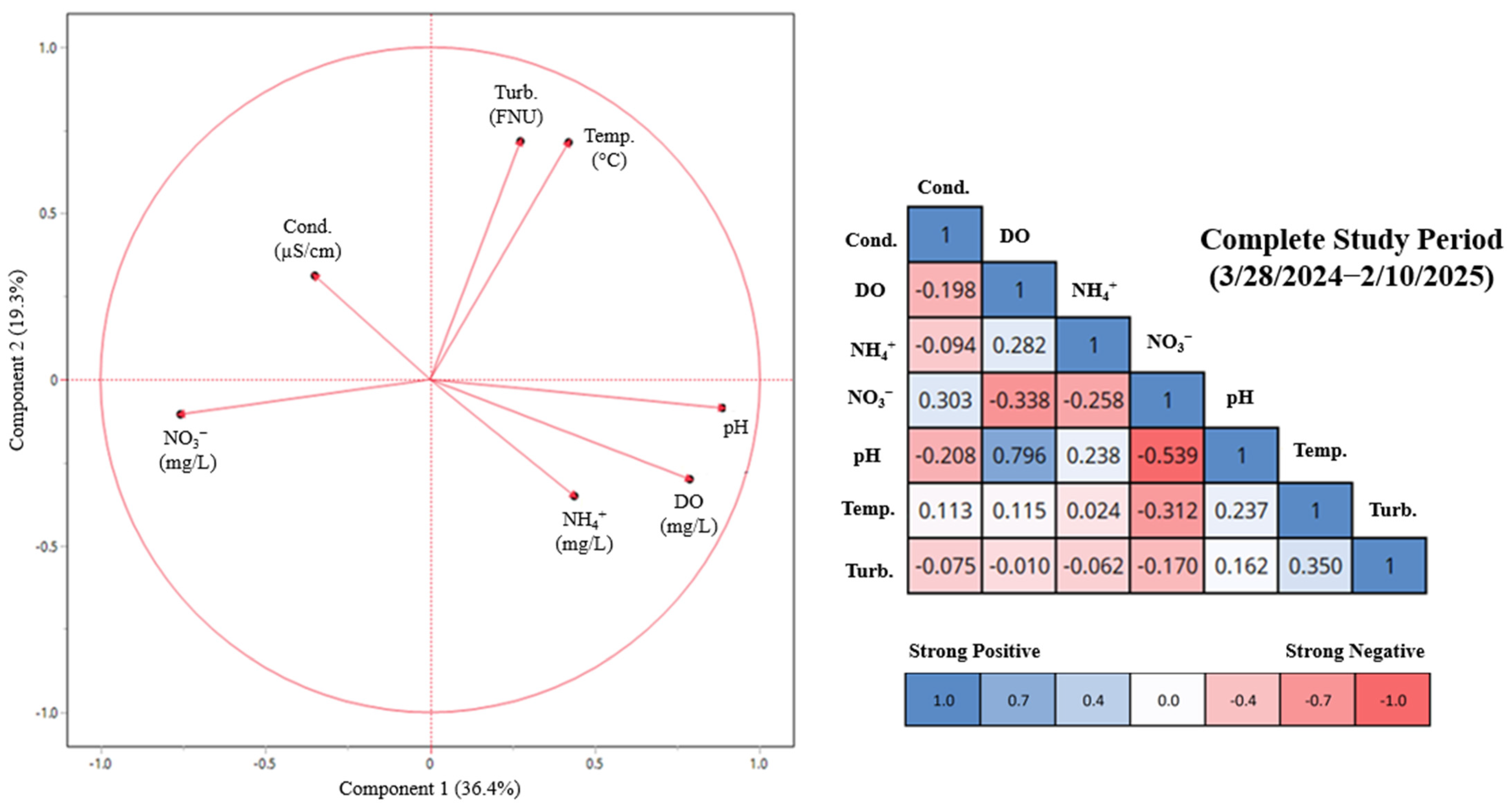
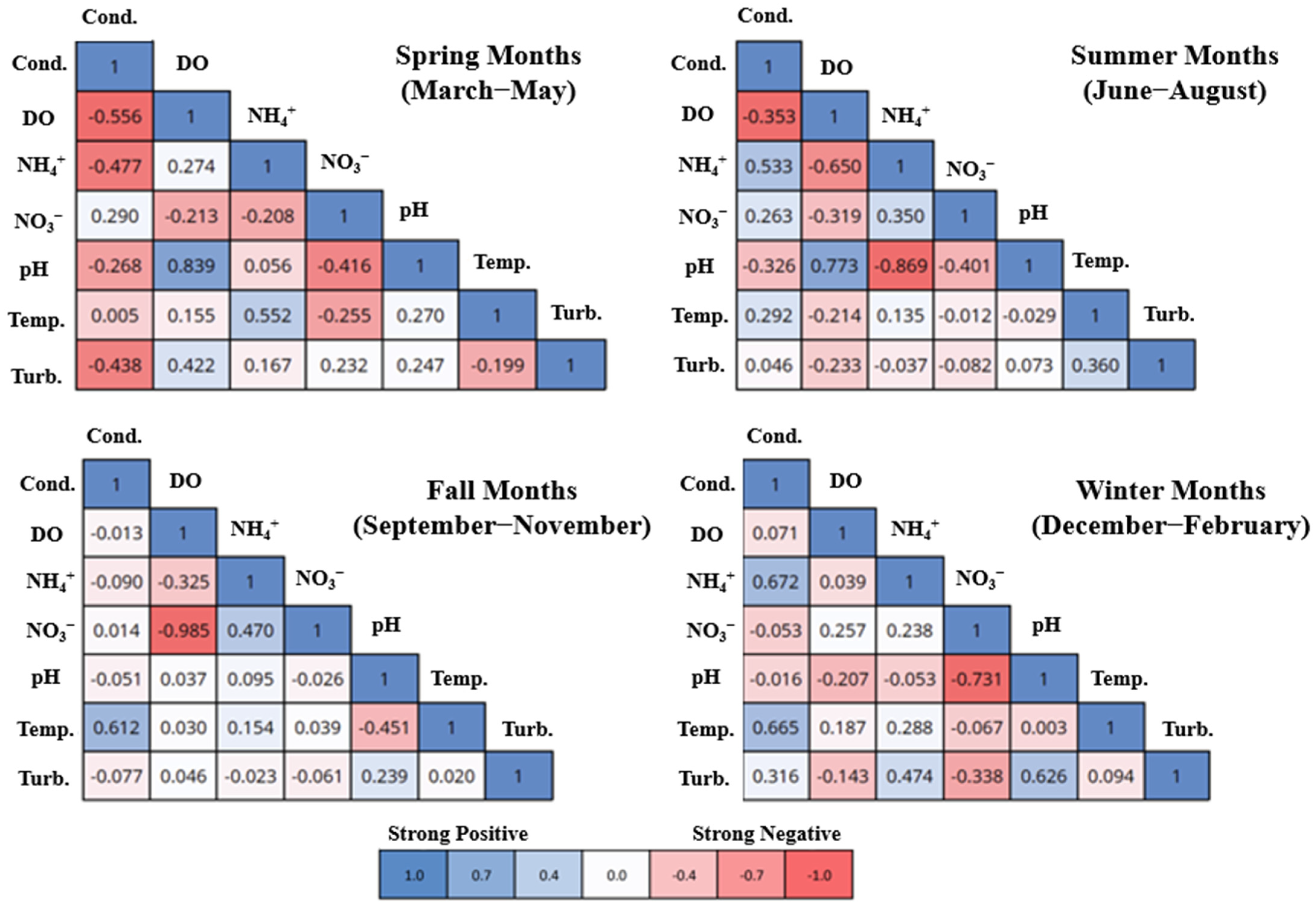
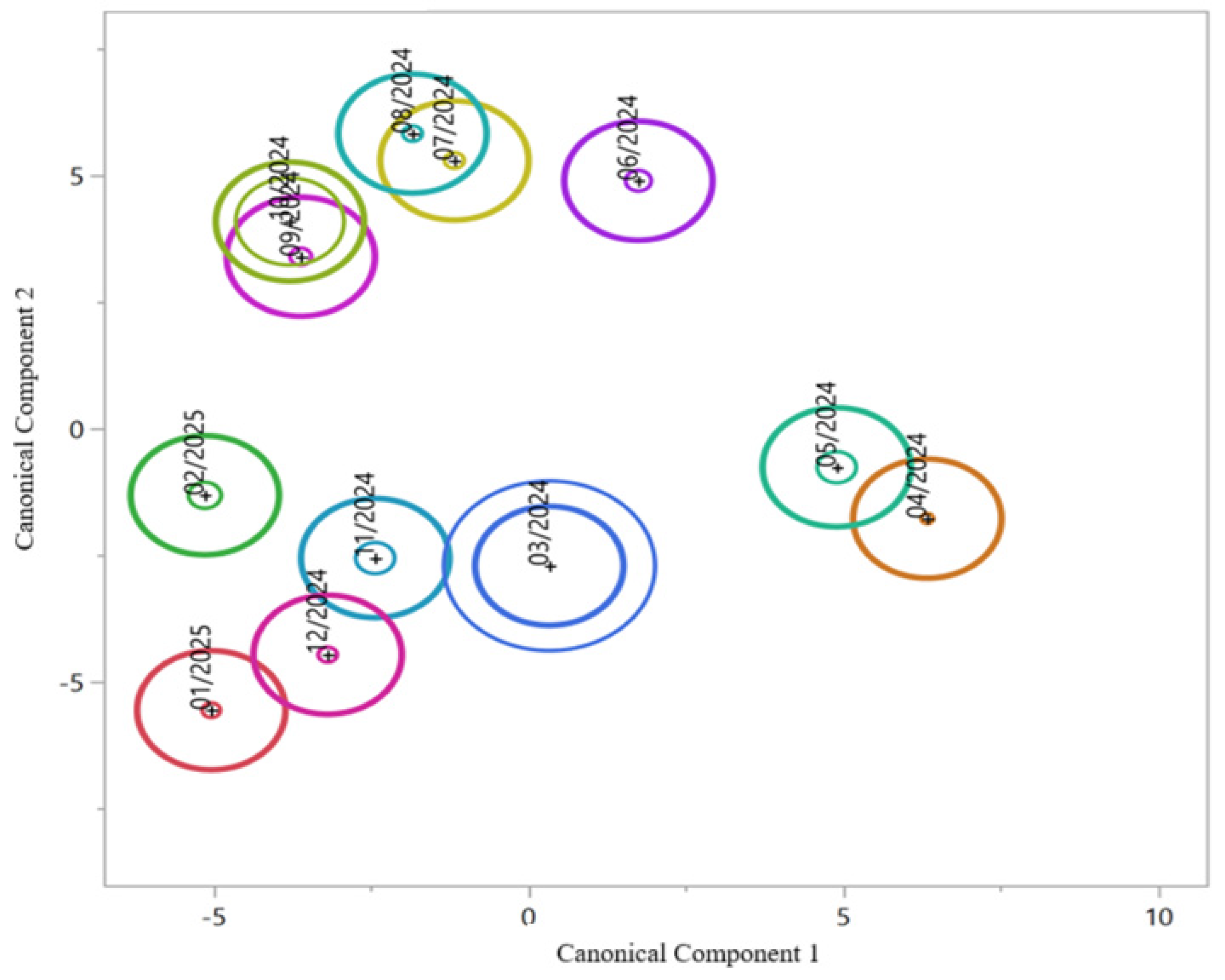
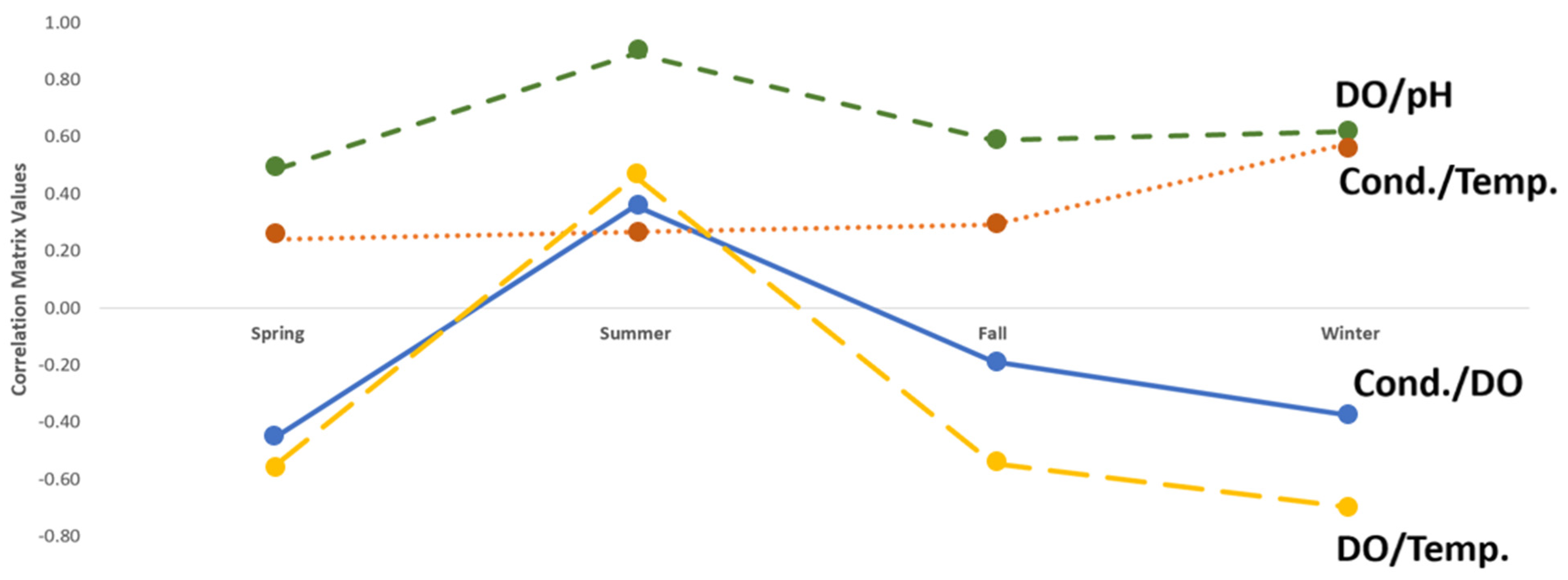
| Parameter | Abbreviate | Unit |
|---|---|---|
| Ammonium | NH4+ | mg/L |
| Conductivity Dissolved Oxygen Nitrate pH Temperature Turbidity | Cond. DO NO3− pH Temp. Turb. | µS/cm mg/L mg/L - °C FNU |
| Month-Year | Total Data Points | Cond. µS/cm | DO mg/L | NH4+ mg/L | NO3− mg/L | pH | Temp. °C | Turb. FNU |
|---|---|---|---|---|---|---|---|---|
| March-2024 | 335 * | 602.5 | 4.9 | 48.1 | 642.6 ¥ | 7.8 | 19.7 | 37.5 |
| April-2024 | 2779 * | 634.4 | 3.5 | 49.2 | 208.7 ¥ | 7.7 | 22.0 | 54.9 |
| May-2024 | 744 | 615.2 | 2.9 | 50.5 | 268.5 ¥ | 7.6 | 25.4 | 117.6 |
| June-2024 | 599 | 647.5 | 3.4 | 38.9 | 427.0 ¥ | 7.6 | 27.7 | 75.8 |
| July-2024 | 744 | 638.0 | 3.6 | 20.3 | 396.8 ¥ | 7.7 | 28.4 | 28.7 |
| August-2024 | 743 | 654.4 | 3.0 | 138.7 | 303.8 ¥ | 7.7 | 28.4 | 38.0 |
| September-2024 | 720 | 623.6 | 3.0 | 222.3† | 380.6 ¥ | 7.6 | 26.6 | 59.9 |
| October-2024 | 743 | 645.8 | 3.2 | 21.2 | 669.9 ¥ | 7.7 | 23.1 | 61.1 |
| November-2024 | 719 | 582.1 | 3.2 | 20.2 | 1744.2 † | 7.6 | 22.7 | 69.1 |
| December-2024 | 744 | 532.6 | 4.7 | 19.7 | 265.1 ¥ | 7.7 | 17.7 | 74.9 |
| January-2025 | 744 | 489.7 | 5.4 | 15.0 | 182.5 | 7.7 | 15.2 | 80.9 |
| February-2025 | 669 | 569.0 | 4.6 | 69.5 | 46.7 | 7.7 | 17.9 | 90.0 |
| March-2025 | 743 | 619.5 | 4.0 | 94.6 | 51.2 | 7.7 | 19.7 | 96.6 |
| April-2025 | 720 | 698.2 | 3.0 | 95.0 | 91.7 | 7.6 | 22.9 | 189.1 |
| May-2025 | 744 | 686.5 | 2.5 | 1245.8 † | 92.0 | 7.6 | 24.9 | 138.1 |
| Month-Year | Total Data Points | Cond. µS/cm | DO mg/L | NH4+ mg/L | NO3− mg/L | pH | Temp. °C | Turb. FNU |
|---|---|---|---|---|---|---|---|---|
| March-2024 | 330 * | 605.9 | 0.9 | 51.9 | 7.2 | 7.2 | 19.9 | 15.2 |
| April-2024 | 2778 * | 697.7 | 3.1 | 116.4 | 151.0 | 7.2 | 22.8 | 110.5 |
| May-2024 | 744 | 650.2 | 1.7 | 97.6 | 95.2 | 7.2 | 27.0 | 40.3 |
| June-2024 | 719 | 628.0 | 2.9 | 2.4 | 36.0 | 7.4 | 29.7 | 284.5 |
| July-2024 | 744 | 669.2 | 0.1 | 12.0 | 46.1 | 6.9 | 30.0 | 595.0 |
| August-2024 | 743 | 703.0 | 0.1 | 12.6 | 206.3 ¥ | 6.9 | 30.4 | 348.4 |
| September-2024 | 719 | 848.5 | 0.0 | 39.4 | 544.6 ¥ | 6.7 | 27.2 | 46.5 |
| October-2024 | 747 | 567.5 | 0.0 | 117.3 | 2039.3 † | 6.9 | 23.2 | 62.8 |
| November-2024 | 720 | 596.8 | 0.0 | 6.7 | 2259.7 † | 6.8 | 22.4 | 66.5 |
| December-2024 | 743 | 686.6 | 0.0 | 9.3 | 155.2 | 6.9 | 16.0 | 15.8 |
| January-2025 | 744 | 649.7 | 0.0 | 10.3 | 450.7 ¥ | 6.7 | 13.3 | 13.9 |
| February-2025 | 226 | 749.2 | 0.6 | 10.7 | 625.5 ¥ | 6.7 | 19.1 | 10.8 |
Disclaimer/Publisher’s Note: The statements, opinions and data contained in all publications are solely those of the individual author(s) and contributor(s) and not of MDPI and/or the editor(s). MDPI and/or the editor(s) disclaim responsibility for any injury to people or property resulting from any ideas, methods, instructions or products referred to in the content. |
© 2025 by the authors. Licensee MDPI, Basel, Switzerland. This article is an open access article distributed under the terms and conditions of the Creative Commons Attribution (CC BY) license (https://creativecommons.org/licenses/by/4.0/).
Share and Cite
Marcantel, M.; Bappy, M.; Hayes, M. Investigating Seasonal Water Quality Dynamics in Humid, Subtropical Louisiana Facultative Waste Stabilization Ponds. Water 2025, 17, 2936. https://doi.org/10.3390/w17202936
Marcantel M, Bappy M, Hayes M. Investigating Seasonal Water Quality Dynamics in Humid, Subtropical Louisiana Facultative Waste Stabilization Ponds. Water. 2025; 17(20):2936. https://doi.org/10.3390/w17202936
Chicago/Turabian StyleMarcantel, Mason, Mahathir Bappy, and Michael Hayes. 2025. "Investigating Seasonal Water Quality Dynamics in Humid, Subtropical Louisiana Facultative Waste Stabilization Ponds" Water 17, no. 20: 2936. https://doi.org/10.3390/w17202936
APA StyleMarcantel, M., Bappy, M., & Hayes, M. (2025). Investigating Seasonal Water Quality Dynamics in Humid, Subtropical Louisiana Facultative Waste Stabilization Ponds. Water, 17(20), 2936. https://doi.org/10.3390/w17202936






